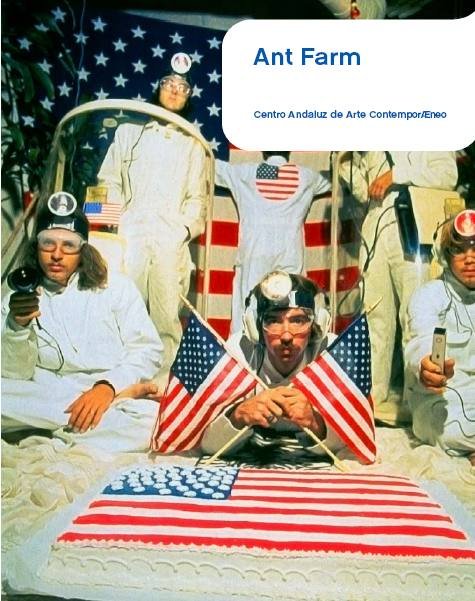Ant Farm
dal 11/2/2008 al 7/6/2008
Segnalato da
Centro Andaluz de Arte Contemporanea
11/2/2008
Ant Farm
Centro Andaluz de Arte Contemporaneo, Sevilla

In 1968, Doug Michels and Chip Lord
founded Ant Farm, a group of radical
architects based on the West Coast of the
US, from San Francisco to Houston, which
was later joined by Curtis Schreier, Hudson
Marquez and Douglas Hurr.
Their main influences were Buckminster
Fuller, Paolo Soleri and Archigram; as well as
the nomadic lifestyle of and the
choreographic performances by Anna and
Lawrence Halprin. Ant Farm defines itself as
a group of underground architects. They are
fascinated by cars and the pop culture. This
group revealed their conceptual world using
videos, manifestos, performances and
installations until 19778, when their workshop
was burnt down and the group disbanded.
Their inflatables criticise the architectural
brutalism prevalent in the United States
during the 1960s and challenge the American
consumerism culture.
In 1971, the project Media Van featured a
customised Chevrolet van in which they
toured and visited various universities
showing their ICE-9, which was an initiative
close to a happening.
In 1972 the group built in Texas the House
of the Century, a house with organic shapes.
Their projects challenge the contemporary
American culture and its obsession for
consumerism, such as in Freedomland, a
shopping centre for teenagers under an
inflatable dome and wired-up with TV signal
cables.
In The Dolphin Embassy they imagined a
sea station in Australia to research on the
communication between dolphins and
humans using the new video technologies.
Cadillac Ranch (1974), is considered one
of the most well-known pieces in the history
of 20th century art. Ant Farm half-buried 10
Candillac cars nose down in a wheat field,
lining them up in the dessert close to the
mythical Route 66 in Amarillo (Texas). This
installation was subsequently used by Bruce
Springsteen to promote his song Cadillac
Ranch. This piece is close to the Land Art
works by Michael Heizer or Robert Smithson.
However, its composition is much more
subversive, using the car as an icon of the
American culture and referring to an
industrial society which had already started
to decline, as could be seen in the obsolete
city of Detroit, the quintessential cradle of
automobile manufacturing. The monumental
dimension of this installation -often even
compared with Stonehenge- takes the
culture of objects to a paroxysmal extreme.
Media Burn (1975), is both video art and
performance. Ant Farm staged the literal
collision between two major icons of the
American culture: automobiles and the
EXHIBITION television.
A customised car crashes against a
pyramid of burning TV sets in front of 400
extras pretending to be spectators. This
project followed a very precise script, which is
a clear feature of the theatrical and narrative
dimension of Ant Farm's installations. This
happening was broadcasted in the local
television. Media Burn stages the destruction
of the media representation, turning media
against themselves, giving them a taste of
their own medicine.
In The Eternal Frame (1975), the group
produces a video recreating the
assassination of President Kennedy. It was
the first collective tragedy and it features
Doug Michels as President Kennedy. This
video fiercely criticises the way events are
portrayed in the communication society:
events are only their media ghostly rendering
and become a continuous repetition of one
single image. Ant Farm projects embrace the
conceptual art practice, architecture and
even theatre or writing, as they have a
narrative dimension, circumscribed within a
circular and syncopated timeframe. Ant
Farm's preformative dimension was partly
inspired in the architecture experimental
workshops organised in San Francisco by
Anna and Lawrence Halprin during the late
1970s and attended by artists, architects,
dancers… These workshops, together with
Robert Venturi's articles analysing the iconic
dimension of architecture, left a clear
footprint on the group.
Ant Farm has been
compared to the radical architecture
prevalent in Europe in the 1960s and carried
out by collectives such as Archigram,
Superstudio, Archizoom, Coop Himmelblau
and Haus-Rucker-Co. However, the group's
unique feature is their social and political
references to the American culture as well as
their iconic and destructive approach to
mass media. Their true radical character lies
in the fact that their projects are not only the
work of art itself, their projects go beyond
that and they are also the mass media
rendering of that work of art.
Centro Andaluz de Arte ContemporÆneo
Monasterio de la Cartuja de Santa María de las Cuevas
Avda. Américo Vespucio, Isla de la Cartuja - Sevilla



